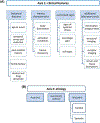Consensus Statement on the classification of tremors. from the task force on tremor of the International Parkinson and Movement Disorder Society
- PMID: 29193359
- PMCID: PMC6530552
- DOI: 10.1002/mds.27121
Consensus Statement on the classification of tremors. from the task force on tremor of the International Parkinson and Movement Disorder Society
Abstract
Background: Consensus criteria for classifying tremor disorders were published by the International Parkinson and Movement Disorder Society in 1998. Subsequent advances with regard to essential tremor, tremor associated with dystonia, and other monosymptomatic and indeterminate tremors make a significant revision necessary.
Objectives: Convene an international panel of experienced investigators to review the definition and classification of tremor.
Methods: Computerized MEDLINE searches in January 2013 and 2015 were conducted using a combination of text words and MeSH terms: "tremor", "tremor disorders", "essential tremor", "dystonic tremor", and "classification" limited to human studies. Agreement was obtained using consensus development methodology during four in-person meetings, two teleconferences, and numerous manuscript reviews.
Results: Tremor is defined as an involuntary, rhythmic, oscillatory movement of a body part and is classified along two axes: Axis 1-clinical characteristics, including historical features (age at onset, family history, and temporal evolution), tremor characteristics (body distribution, activation condition), associated signs (systemic, neurological), and laboratory tests (electrophysiology, imaging); and Axis 2-etiology (acquired, genetic, or idiopathic). Tremor syndromes, consisting of either isolated tremor or tremor combined with other clinical features, are defined within Axis 1. This classification scheme retains the currently accepted tremor syndromes, including essential tremor, and provides a framework for defining new syndromes.
Conclusions: This approach should be particularly useful in elucidating isolated tremor syndromes and syndromes consisting of tremor and other signs of uncertain significance. Consistently defined Axis 1 syndromes are needed to facilitate the elucidation of specific etiologies in Axis 2. © 2017 International Parkinson and Movement Disorder Society.
Keywords: classification; diagnostic axes; etiology; tremor; tremor syndromes.
© 2017 International Parkinson and Movement Disorder Society.
Conflict of interest statement
Full financial disclosures and author roles may be found in the online version of this article.
Figures



Comment in
-
Classifying tremor: Language matters.Mov Disord. 2018 Jan;33(1):3-4. doi: 10.1002/mds.27178. Epub 2017 Nov 30. Mov Disord. 2018. PMID: 29193400 No abstract available.
-
What is "essential" about essential tremor? A diagnostic placeholder.Mov Disord. 2018 Jan;33(1):58-61. doi: 10.1002/mds.27288. Epub 2017 Dec 22. Mov Disord. 2018. PMID: 29272067 No abstract available.
-
Understanding the new tremor classification.Mov Disord. 2018 Aug;33(8):1267-1268. doi: 10.1002/mds.27368. Epub 2018 Mar 23. Mov Disord. 2018. PMID: 29570842 No abstract available.
References
-
- Deuschl G, Bain P, Brin M. Consensus statement of the Movement Disorder Society on Tremor. Ad Hoc Scientific Committee. Mov Disord 1998;13(Suppl 3):2–23. - PubMed
-
- Marsden CD, Obeso JA, Rothwell J. Benign essential tremor is not a single entity. In: Yahr MD, ed. Current Concepts of Parkinson Disease and Related Disorders Amsterdam: Excerpta Medica; 1983:31–46.
-
- Elble R, Deuschl G. Milestones in tremor research. Mov Disord 2011;26:1096–1105. - PubMed
-
- Quinn NP, Schneider SA, Schwingenschuh P, Bhatia KP. Tremor—some controversial aspects. Mov Disord 2011;26:18–23. - PubMed
Publication types
MeSH terms
Grants and funding
LinkOut - more resources
Full Text Sources
Other Literature Sources
Medical

